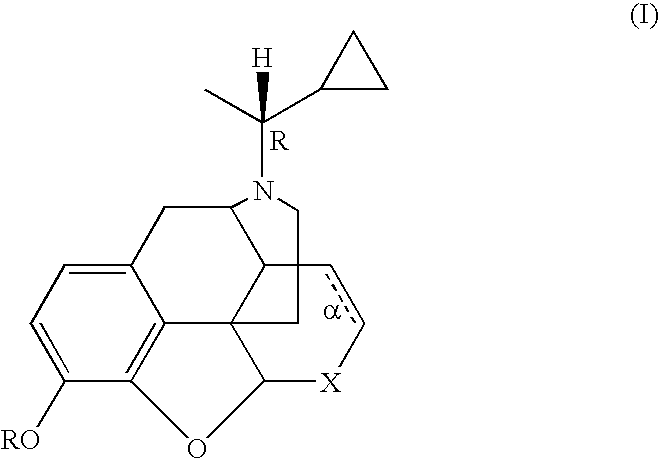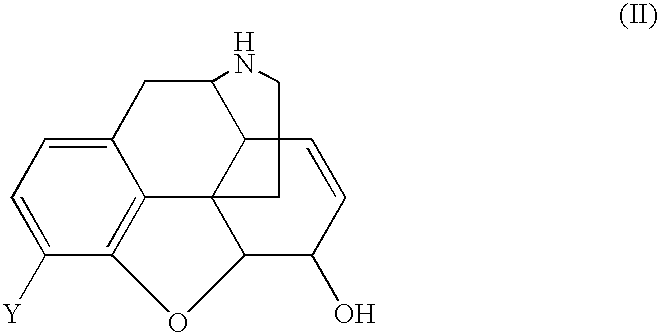Treatment of chemical dependency with substantially nonaddicting normorphine and norcodeine derivatives
a technology of normorphine and norcodeine, which is applied in the field of chemical dependency treatment, can solve the problems of cocaine addiction without pharmacotherapies commercially available, low efficacy of kappa receptor and low efficacy of mu receptor, etc., and achieves the effects of restoring mu receptor levels, reducing drug dependence, and reducing drug dependen
- Summary
- Abstract
- Description
- Claims
- Application Information
AI Technical Summary
Benefits of technology
Problems solved by technology
Method used
Image
Examples
example 1
Preparation OF N-[(1R,S)-1-Cyclopropylethyl]-Norcodeine as a Diastereomeric Mixture
[0078] A solution of 25.3 g (0.066 mol) of N-(1-cyano)-1-ethylnorcodeine (DeGraw et al. (1978) J. Med Chem 21: 495) in 155 mL of THF was slowly added to a solution of cyclopropyl magnesium bromide (from 49.2 g, 0.41 mol of cyclopropyl bromide and 25 g of magnesium) in 750 mL of THF. After 30 min the mixture was poured into 500 mL of 1N HCl and washed with 200 mL of Et2O. The aqueous portion was made strongly alkaline with conc. NH4OH and extracted with 250 mL of CH2Cl2. The extract was dried (MgSO4) and evaporated to leave 16.1 g of crude product. The material was taken up in 100 mL EtOAc-EtOH (95:5) and filtered through 400 g of silica gel in a Buchner filter. The adsorbent was eluted with 3 L of the solvent followed by evaporation of the filtrate to leave 11.8 g (51%) of a yellow gum; TLC (silica gel, EtOAc-EtOH-Et3N, 17:2:1) showed a single UV and 12 absorbing spot at Rf 0.50; representing the tit...
example 2
Preparation OF N-[(1R,S)-1-Cyclopropylethyl]-Normorphine as a Diastereomeric Mixture
[0079] A. To convert the norcodeine derivative prepared in Example 1 to the normorphine derivative, a solution of 24.7 g (0.07 mol) of N-α-methylcyclopropylmethyl-norcodeine in 500 mL of dry tetrahydrofuran was treated with 25 g (0.13 mol) of diphenylphosphine and cooled to 0° C.-5° C. in an ice bath. Then 135 mL of 1.4N butyl lithium in hexane was added rapidly by syringe. The mixture was allowed to warm to room temperature and then stirred at reflux for 30 min. The reaction was cooled and quenched by the slow addition of 100 mL of 2N HCl. The solvents were evaporated in vacuo and the aqueous portion was made strongly alkaline by the addition of 2N NaOH and again washed with 200 mL of ether. The pH was adjusted to 8-9 and the mixture extracted twice with 200 mL portions CH2Cl2. The extract was dried (MgSO4) and evaporated in vacuo to leave 10.7 g of the crude free base. The material was chromatogra...
example 3
Preparation OF N-[(1R)-1-Cyclopropylethyl]-Normorphine Dibenzoate and N-[(1S)-1-Cyclopropylethyl]-Normorphine Dibenzoate
[0082] The solution of the diastereomeric mixture prepared in Example 2 (5.0 g, 14.7 mM) in 50 mL of pyridine was treated dropwise with 6.1 g (43 mM) of benzoyl chloride was maintenance of the temperature at or below 50° C. After 30 min the mixture was treated with 5 mL of CH3OH and evaporated in vacuo. The residue was partitioned between 100 mL of CH2Cl2 and 50 mL of 3N HCl. The CH2Cl2 extract (containing the product) was washed with saturated NaHCO3 (50 mL) and dried over MgSO4. After filtration through a short pad of silica gel (50 g) with elution by EtOAc, the solvent was removed in vacuo to leave 6.3 g (86%) of a yellow gum. The mixture was separated by preparative HPLC on silica gel with elution by EtOAc:hexane:CH3OH, 9:9:2). The enriched fractions were combined and evaporated to afford the A diastereomer (2.20 g, 35%) and B diastereomer (2.03 g, 32%). Each ...
PUM
| Property | Measurement | Unit |
|---|---|---|
| temperature | aaaaa | aaaaa |
| time | aaaaa | aaaaa |
| acid | aaaaa | aaaaa |
Abstract
Description
Claims
Application Information
 Login to View More
Login to View More - R&D
- Intellectual Property
- Life Sciences
- Materials
- Tech Scout
- Unparalleled Data Quality
- Higher Quality Content
- 60% Fewer Hallucinations
Browse by: Latest US Patents, China's latest patents, Technical Efficacy Thesaurus, Application Domain, Technology Topic, Popular Technical Reports.
© 2025 PatSnap. All rights reserved.Legal|Privacy policy|Modern Slavery Act Transparency Statement|Sitemap|About US| Contact US: help@patsnap.com



